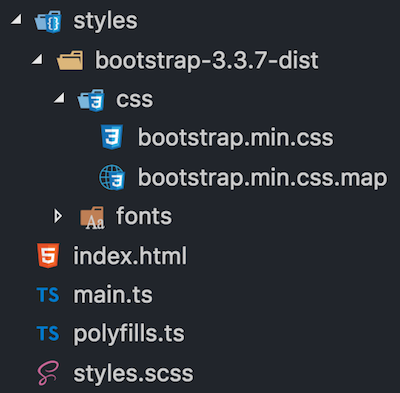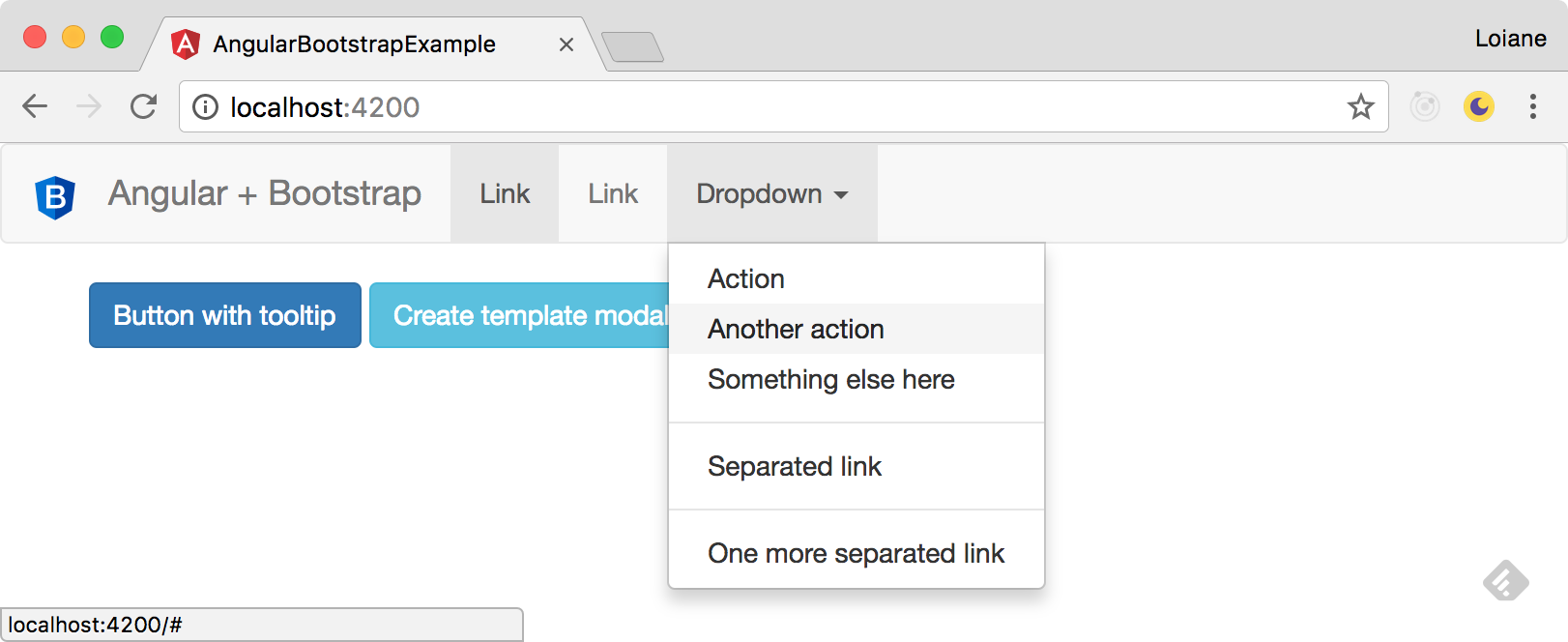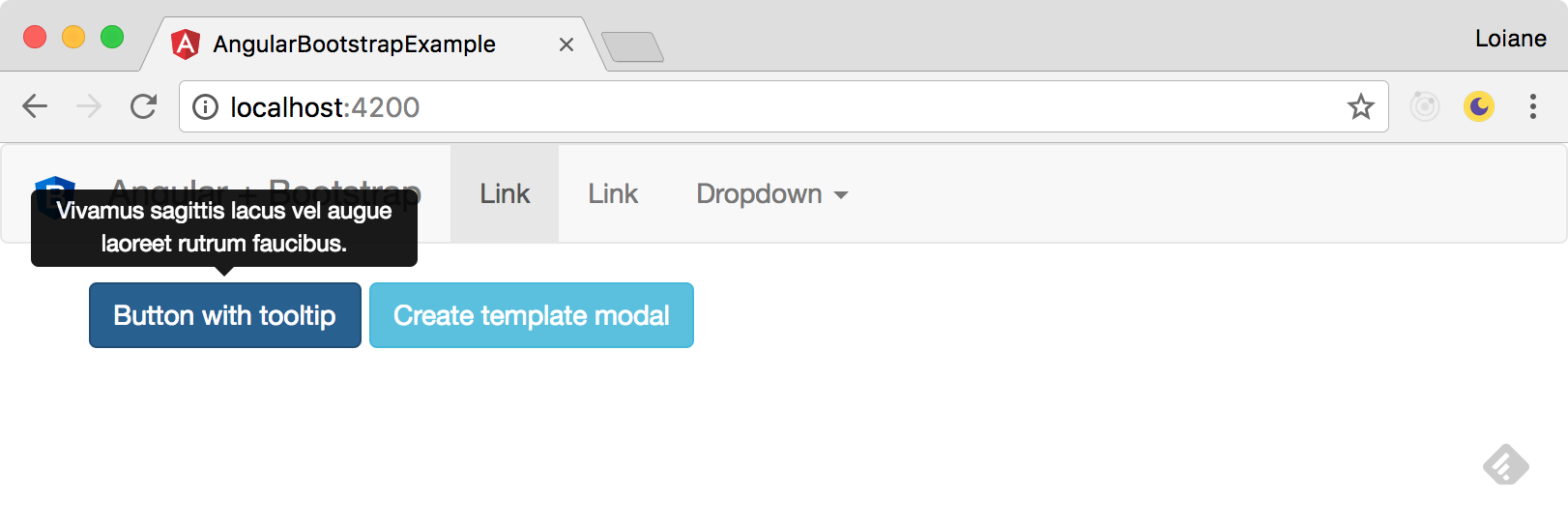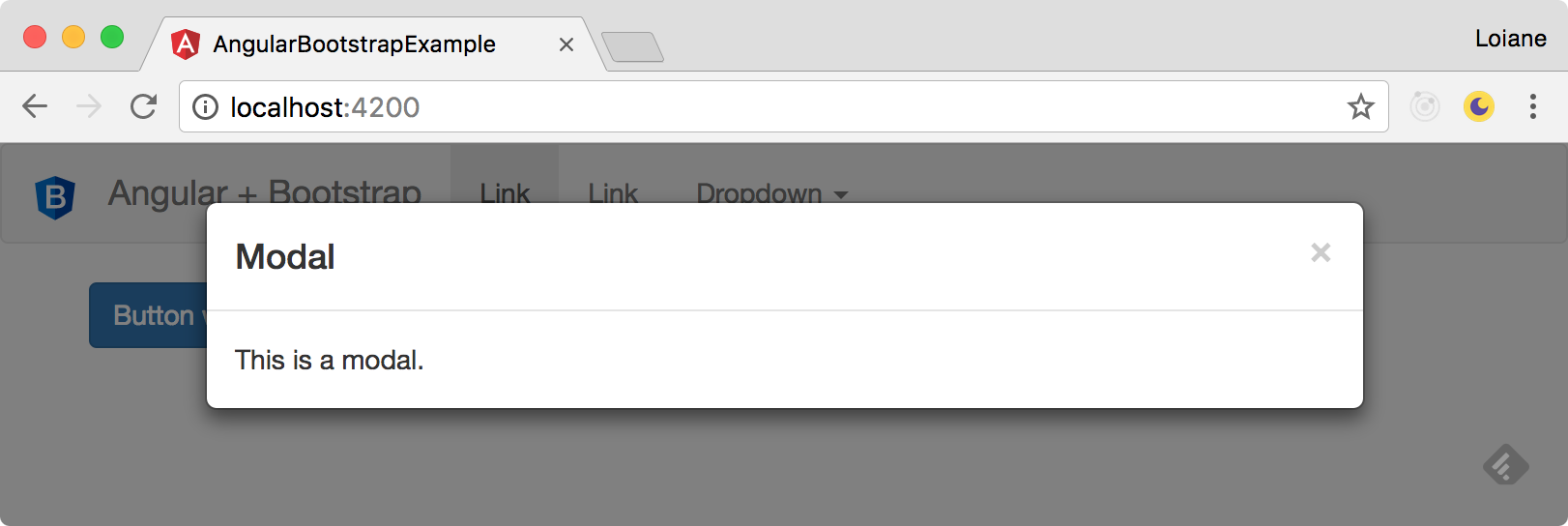[转]How to Add Bootstrap to an Angular CLI project
本文转自:https://loiane.com/2017/08/how-to-add-bootstrap-to-an-angular-cli-project/
In this article we will learn how to setup an Angular project with Bootstrap 3 or Bootstrap 4.
Update May 2018: code updated to Angular v6. Stackblitz link also available at the end of this article.
Contents
Although the setup seems simple, I still get a lot of questions on how to setup an Angular project generated with Angular CLI with Bootstrap. So let’s see the step by step in the sections below.
1: Creating an Angular project with Angular CLI
The first step is creating your Angular project using Angular CLI.
For this example we will use the following command:
ng new angular-bootstrap-example
2: Installing Bootstrap from NPM
Next, we need to install Bootstrap. Change the directory to the project we created (cd angular-bootstrap-example) and execute the following command:
For Bootstrap 3:
npm install bootstrap@3.3.7
For Bootstrap 4:
npm install bootstrap
2.1: Alternative: Local Bootstrap CSS
As an alternative, you can also download the Bootstrap CSS and add it locally to your project. I donwloaded Bootstrap from the website and created a folder styles (same level as styles.css):

Don’t place your local CSS files under
assetsfolder. When we do the production build with Angular CLI, the CSS files declared in theangular.jsonwill be minified and all styles will be bundled into a single styles.css. The assets folder is copied to the dist folder during the build process (the CSS code will be duplicated). Only place your local CSS files underassetsin case you are importing them directly in theindex.html.
3: Importing the CSS
We have two options to import the CSS from Bootstrap that was installed from NPM:
1: Configure angular.json:
"styles": [
"node_modules/bootstrap/dist/css/bootstrap.min.css",
"styles.scss"
]2: Import directly in src/style.css or src/style.scss:
@import '~bootstrap/dist/css/bootstrap.min.css';
I personally prefer to import all my styles in src/style.css since it’s been declared in angular.json already.
3.1 Alternative: Local Bootstrap CSS
If you added the Bootstrap CSS file locally, just import it in angular.json
"styles": [
"styles/bootstrap-3.3.7-dist/css/bootstrap.min.css",
"styles.scss"
],or src/style.css:
@import './styles/bootstrap-3.3.7-dist/css/bootstrap.min.css';
With this setup we are able to start using the Bootstrap CSS classes in our project.
4: Bootstrap JavaScript Components with ngx-bootstrap (Option 1)
In case you don’t need to use Bootstrap JavaScript components (that require JQuery), this is all the setup you need. But if you need to use modals, accordion, datepicker, tooltips or any other component, how can we use these components without installing jQuery?
There is an Angular wrapper library for Bootstrap called ngx-bootstrap that we can also install from NPM:
npm install ngx-bootstrap --save
ng2-bootstrapandngx-bootstrapare the same package. ng2-bootstrap was renamed to ngx-bootstrap after#itsJustAngular.
In case you want to install Bootstrap and ngx-bootstrap at the same time when you create your Angular CLI project:
npm install bootstrap ngx-bootstrap --save
4.1: Adding the required Bootstrap modules in app.module.ts
Go through the ngx-bootstrap and add the modules needed in your app.module.ts. For example, suppose we want to use the Dropdown, Tooltip and Modal components:
import { BsDropdownModule } from 'ngx-bootstrap/dropdown';
import { TooltipModule } from 'ngx-bootstrap/tooltip';
import { ModalModule } from 'ngx-bootstrap/modal';
@NgModule({
imports: [
BrowserModule,
BsDropdownModule.forRoot(),
TooltipModule.forRoot(),
ModalModule.forRoot()
],
// ...
})
export class AppBootstrapModule {}
Because we call the .forRoot() method for each module (due the ngx-bootstrap module providers), the functionalities will be available in all components and modules of your project (global scope).
As an alternative, if you would like to organize the ngx-bootstrap in a different module (just for organization purposes in case you need to import many bs modules and don’t want to clutter your app.module), you can create a module app-bootstrap.module.ts, import the Bootstrap modules (using forRoot()) and also declare them in the exports section (so they become available to other modules as well).
import { NgModule } from '@angular/core';
import { CommonModule } from '@angular/common';
import { BsDropdownModule } from 'ngx-bootstrap/dropdown';
import { TooltipModule } from 'ngx-bootstrap/tooltip';
import { ModalModule } from 'ngx-bootstrap/modal';
@NgModule({
imports: [
CommonModule,
BsDropdownModule.forRoot(),
TooltipModule.forRoot(),
ModalModule.forRoot()
],
exports: [BsDropdownModule, TooltipModule, ModalModule]
})
export class AppBootstrapModule {}
At last, don’t forget to import your bootstrap module in you app.module.ts.
import { AppBootstrapModule } from './app-bootstrap/app-bootstrap.module';
@NgModule({
imports: [BrowserModule, AppBootstrapModule],
// ...
})
export class AppModule {}
ngx-bootstrap works with Bootstrap 3 and 4. And I also made some tests and most of the functionalities also work with Bootstrap 2.x (yes, I still have some legacy code to maintain).
5: Let’s code!
Now that we have the setup for CSS and JavaScript components completed, let’s add some code to our app.component.html:
<nav class="navbar navbar-default">
<div class="container-fluid">
<div class="navbar-header">
<a class="navbar-brand">
<img src="assets/img/ngx-bootstrap.svg" class="logo">
</a>
<span class="navbar-brand">Angular + Bootstrap</span>
</div>
<ul class="nav navbar-nav">
<li class="active"><a href="#">
Link <span class="sr-only">(current)</span>
</a></li>
<li><a href="#">Link</a></li>
<li class="dropdown" dropdown> <!-- {1} -->
<a dropdownToggle role="button"> <!-- {2} -->
Dropdown <span class="caret"></span></a>
<ul *dropdownMenu class="dropdown-menu"> <!-- {3} -->
<li><a href="#">Action</a></li>
<li><a href="#">Another action</a></li>
<li><a href="#">Something else here</a></li>
<li role="separator" class="divider"></li>
<li><a href="#">Separated link</a></li>
<li role="separator" class="divider"></li>
<li><a href="#">One more separated link</a></li>
</ul>
</li>
</ul>
</div>
</nav>
For the DropDown component, ngx-bootstrap provides some directives:
{1}: dropdown directive: use this directive instead of class="dropdown".
{2}: dropdownToggle directive: use this directive instead of class="dropdown-toggle" data-toggle="dropdown". It will also add the aria atributes to the HTML element.
{3}: dropdownMenu directive: use this directive instead of class="dropdown-menu".
And you’ll have the same behavior as Bootstrap + Jquery:

Let’s also develop a button with a tooltip:
<button type="button" class="btn btn-primary"
tooltip="Vivamus sagittis lacus vel augue laoreet rutrum faucibus.">
Button with tooltip
</button>
The tooptip directive has the same effect as data-toggle="tooltip" title="Tooltip text".

Let’s also take a look how to use a Modal component:
<button type="button" class="btn btn-info"
(click)="openModal(template)">Create template modal</button>
<ng-template #template>
<div class="modal-header">
<h4 class="modal-title pull-left">Modal</h4>
<button type="button" class="close pull-right"
aria-label="Close" (click)="modalRef.hide()">
<span aria-hidden="true">×</span>
</button>
</div>
<div class="modal-body">
This is a modal.
</div>
</ng-template>
In the code above, note the we are using a ng-template as container of our modal template. This template is being referenced by a template local variable template. When the user clicks on the button, we tell our code to open the modal referenced by template (you can have as many modals as needed, just give different names to your local variables).
There is also a close button in the modal that is calling modalRef.hide().
So we need some TypeScript code in our app.component.ts as well:
import { BsModalRef, BsModalService } from 'ngx-bootstrap/modal';
@Component({
// ..
})
export class AppComponent {
public modalRef: BsModalRef; // {1}
constructor(private modalService: BsModalService) {} // {2}
public openModal(template: TemplateRef<any>) {
this.modalRef = this.modalService.show(template); // {3}
}
}
{1}: first we need a variable to keep a reference of our modal. This is going to be used to close the modal.
{2}: to show the modal, we also need the ngx-bootstrap service
{3}: and when the user clicks on the button to open the popup we keep the modal reference and pass the template local name to the modalService.

ngx-bootstrap source code is still using Angular v2.x. Since there were no major breaking changes from v2.x to v.4x, it’s ok to use with v4.x. However, some ngx-bootstrap components use
<template>instead of<ng-template>, so you might get warnings in your browser console related totemplatebeing deprecated. For the examples, such as the modal, replacetemplatewithng-templatein your code and you should be fine.
We have an Angular project using Bootstrap and did not need to import JQuery to have the same behavior!
6: Bootstrap 4 JavaScript Components with ng-bootstrap (Option 2)
There is also a second option to use Bootstrap JavaScript components in Angular without JQuery in case you are using Bootstrap 4: ng-bootstrap.
You can install ng-bootstrap in your project from NPM:
npm install --save @ng-bootstrap/ng-bootstrap
In your app.module.ts you need to import the NgbModule.forRoot() using the forRoot() method.
import { NgbModule } from '@ng-bootstrap/ng-bootstrap';
@NgModule({
imports: [ NgbModule.forRoot(), ... ],
// ...
})
export class AppModule {}
If you have feature modules in your application, you also need to import NgbModule, but without the forRoot() method:
Other modules in your application can simply import NgbModule:
import {NgbModule} from '@ng-bootstrap/ng-bootstrap';
@NgModule({
// ...
imports: [NgbModule, ...],
})
export class OtherModule {
}
Source code + live demo + Stackblitz
Source code available on GitHub
References:
Happy coding!
[转]How to Add Bootstrap to an Angular CLI project的更多相关文章
- Using Sass with the Angular CLI
https://www.tuicool.com/articles/mauiMzY One of the first things you'll usually do in a project is t ...
- Configure a proxy for your API calls with Angular CLI
Table of contents Local development setup with Angular Issue: Dev server plus backend API Configurin ...
- 从Java角度理解Angular之入门篇:npm, yarn, Angular CLI
本系列从Java程序员的角度,带大家理解前端Angular框架. 本文重点介绍Angular的开发.编译工具:npm, yarn, Angular CLI,它们就像Java在中的Maven,同时顺便介 ...
- (转载)从Java角度理解Angular之入门篇:npm, yarn, Angular CLI
本系列从Java程序员的角度,带大家理解前端Angular框架. 本文是入门篇.笔者认为亲自动手写代码做实验,是最有效最扎实的学习途径,而搭建开发环境是学习一门新技术最需要先学会的技能,是入门的前提. ...
- @angular/cli项目构建--组件
环境:nodeJS,git,angular/cli npm install -g cnpm --registry=https://registry.npm.taobao.org cnpm instal ...
- Angular环境准备和Angular cli
Angular4.0来了,更小,更快,改动少 接下来为Angular4.0准备环境和学会使用Angular cli项目 1.环境准备: 1)在开始工作之前我们必须设置好开发环境 如果你的机器上还没有安 ...
- Angular CLI 安装和使用
1.背景介绍 关于Angular版本,Angular官方已经统一命名Angular 1.x同一为Angular JS:Angular 2.x及以上统称Angular: CLI是Command Line ...
- .Net Core + Angular Cli / Angular4 开发环境搭建
一.基础环境配置 1.安装VS 2017 v15.3或以上版本 2.安装VS Code最新版本 3.安装Node.js v6.9以上版本 4.重置全局npm源,修正为 淘宝的 NPM 镜像: npm ...
- [Docker] Running Multiple Containers for an Angular, Node project
The code is from Plusight course, github link is here. In this post, we will give a overview about h ...
随机推荐
- npm: 权限阻止修复
在使用 npm install 时,总提示: Error: EACCES: permission denied 今天通过这个命令设置了权限解决了问题: sudo chown -R $(whoami) ...
- web项目中对post请求乱码处理
<filter> <filter-name>characterEncoding</filter-name> <filter-class>org.spri ...
- Django积木块五——分页
分页 django本身带有分页功能,为什么要用他呢?因为它的代码更为简洁,并且在做筛选的时候会把url中的所有参数都组装起来,并且加上分页.也就是做筛选中的结果也可以用这个分页. pip instal ...
- Shell变量类型和运算符-2
- c语言编程上次输入影响下次记过怎么解决要交作业啦求大神相助
秦时鸥总算知道为什么这里这么多的房屋了,当一座吧台和一张张台球桌清理出来的时候他才发现,原来这渔场还有酒吧和桌球厅.
- jQuery常用选择器总结
jQuery常用选择器总结: 我们都知道jQuery是JavaScript(JS)的框架,它的语法简单使用方便,被广大开发人员青睐.现在我就它常用的并且十分强大的选择器的方式,做一个总结.鉴于它的选择 ...
- J2EE导论 | 疑惑篇
J2EE是Java程序员从新手进阶的一个必经之路.要体会所谓的工业级代码,就必须要融入和经历更为复杂的开发.部署环境,需要同更多的模块.组件做信息流交换,比较和使用不同的框架,逐一去琢磨和考察它们的必 ...
- 如何推翻JAVA的统治地位?
“java越来越过份了.”php狠狠的说,他转头看着C:“C哥,您可是前辈,java最近砸了我不少场子,您老再不出来管管,我怕他眼里就没有您了啊.” C哥吸烟,慢慢的说:“年轻人不要着急,java的根 ...
- [Swift]JSON字符串与字典(Dictionary)、数组(Array)之间的相互转换
1.JSON字符串与字典(Dictionary)之间的相互转换 import Foundation //JSON字符串转换为字典(Dictionary) func getDictionaryFromJ ...
- [Postman]Cookies(12)
Postman的本机应用程序提供 MANAGE COOKIES 模式,允许您编辑与每个域关联的Cookie. 前往cookie经理 要打开MANAGE COOKIES模式,请单击“ 发送”按钮下的 ...
